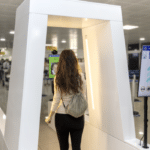TSA developing wearable sensors to replace physical pat downs

The Transportation Security Administration (TSA) and Department of Homeland Security’s (DHS) Science and Technology Directorate (DHS S&T) are jointly developing a wearable device known as the Wearable Sensor for Contactless Physical Assessment, or WSCPA, which could transform how TSA conducts passenger screenings at U.S. airports.
WSCPA technology, if deployed, would allow contactless physical assessments that preserve passenger privacy while improving detection accuracy and safety for TSA officers.
The WSCPA is being designed as a wearable device that uses advanced touchless sensor technology to detect, interpret, and relay physical information about a person or object without the need for direct contact. At the core of this system is a combination of haptic feedback and 3D sensing capabilities. This allows a TSA officer to “feel” or sense the contours and composition of concealed items through tactile simulation.
“The innovation uses touchless sensors to register the object’s contours and generate feedback to physically replicate the target object, enabling physical sensation and assessment without direct contact,” DHS has said, adding that “the subject technology can minimize potential harm when touching unsafe objects, preserve individual privacy during a security screening, or safely provide physical awareness for visually impaired individuals.”
Using non-contact radar or ultrasound-based sensors, the device can detect variations in density, shape, and potentially even material composition, and then convert that data into physical feedback a user can interpret through their wearable interface. It is, in effect, a way to digitally mimic the human sense of touch across distance, without ever physically laying hands on the subject, and represents a shift from the traditional pat-down procedures which are widely viewed as invasive and often subject to criticism by civil rights groups.
“Virtual reality (VR) technologies simulate environments that allow users to sense virtual objects and experiences,” DHS says, noting that “VR systems digitally immerse users through simulated sensations delivered through head-mounted displays, gloves, suits, and other wearable devices. Compared to sight, hearing, and smell, touch-based sensing is harder to replicate virtually because the hand’s sensory and motor nerves are more complex than other body parts.”
The project has been in the conceptual and early prototyping phase for several years, originating as part of DHS S&T’s push to expand the application of wearable and sensor-based technology in both security and first responder contexts. According to public-facing documentation from DHS S&T, WSCPA was conceived to address key challenges faced by TSA agents, chief among them reducing the need for physical searches without compromising on the quality of threat detection.
A secondary objective is to create a tool that is scalable beyond the airport environment, making it viable for use by law enforcement, customs officers, and potentially medical personnel in situations where touchless assessment is beneficial.
What sets WSCPA apart from other security screening technologies currently deployed by TSA – such as millimeter wave scanners and computed tomography scanners – is its operational proximity and portability. Rather than requiring a person to step into a machine or place their belongings on a conveyor belt, WSCPA would be worn directly by a TSA officer and used as they move around a subject.
The device could function like a “digital glove” or a mounted wrist device that provides haptic feedback corresponding to detected anomalies, contours, or inconsistencies beneath a person’s clothing. This haptic interface would likely include vibration patterns, pressure simulations, or other tactile cues to help the officer differentiate between benign items and potential threats.
The scientific underpinnings of WSCPA involve touchless sensing modalities that include radar, lidar, and capacitive or ultrasonic technologies. These sensors can scan surfaces or bodies and reconstruct three-dimensional representations of objects underneath clothing without capturing photographic images, which is important for maintaining privacy protections.
Advanced machine learning algorithms could be employed to enhance interpretation accuracy, helping differentiate between organic and inorganic materials, or between harmless everyday items and more suspicious shapes or compositions.
From a privacy and civil liberties standpoint, the appeal of WSCPA is significant. One of the consistent criticisms levied against TSA screenings is the invasive nature of pat-downs, which have in some cases resulted in legal challenges and formal complaints.
With WSCPA, however, there is a clear intention to reduce the frequency and invasiveness of these physical inspections by allowing officers to perform similar checks with far less direct contact. It would be particularly beneficial in accommodating travelers with trauma sensitivities, religious concerns regarding physical contact, or medical conditions that make pat-downs uncomfortable or unsafe.
This technology also holds promise from a public health perspective. The COVID-19 pandemic amplified the need for low-contact and contactless solutions across many facets of public life, particularly in transportation and healthcare. Tools like WSCPA would allow TSA officers to maintain a safe distance while still conducting effective screenings, reducing the risk of transmission of any contagious illnesses during close-proximity inspections.
In terms of its broader potential applications, WSCPA is not limited to aviation security. DHS has suggested that the technology could also be used by customs officers at land ports of entry, federal protective service personnel guarding sensitive facilities, or even by first responders searching for victims under debris where visual inspection is limited. Its flexibility as a wearable device means it can be integrated into existing uniforms or equipment with minimal disruption, allowing for modular use depending on the situation.
However, despite its many proposed benefits, WSCPA is not without its challenges. The technology is still in development and has not yet undergone large-scale field testing. Questions remain regarding its sensitivity, specificity, false positive and false negative rates, and how it would perform in high-traffic environments like TSA checkpoints or border ports of entry.
Additionally, the integration of haptic feedback must be intuitive enough that officers can make reliable judgments quickly without being overwhelmed by sensory data. Training protocols would need to be developed to ensure the effective use of the device and to avoid misuse or misinterpretation of the data it provides.
Furthermore, as with any advanced sensor system, questions regarding data security, retention policies, and usage oversight will likely arise. While WSCPA does not rely on imaging data in the same way as full-body scanners, the sensor information it collects still constitutes a form of sensitive screening data. Policies will need to be put in place to regulate how that data is processed, whether it is stored, and how it may be audited or reviewed after the fact. Civil liberties advocates will undoubtedly scrutinize its deployment closely to ensure it does not become another vector for unnecessary surveillance.
Another consideration is cost and scalability. Integrating wearable haptic sensors into TSA’s national operations would require both significant investment and a structured deployment plan. Given the financial constraints frequently faced by DHS and TSA, adoption of WSCPA would likely need to be phased in over time, beginning with pilot programs at select airports.
Depending on the results of trials, the technology will either be shelved, improved, or pushed into broader use. At this stage, WSCPA is being marketed by DHS S&T’s Technology Transfer and Commercialization Program for potential partnerships, suggesting that the agency is still looking for industry collaborators to refine, produce, and commercialize the system.
Article Topics
3D sensors | airports | border security | DHS S&T | TSA | virtual reality | wearables








Comments